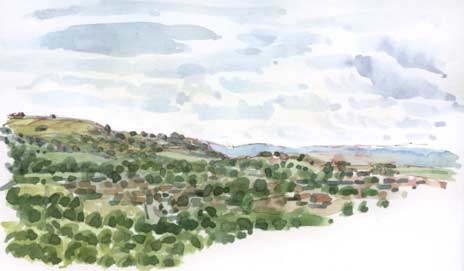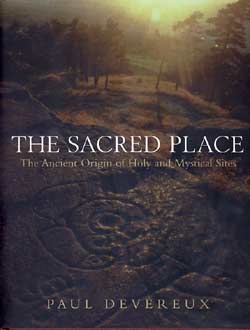
|
A View of ShepleyWednesday, 2nd July 2003, West Yorkshire |
![]()
![]()
![]()
![]() Rocks | History |
Workshop |
Links | Home
Page
Rocks | History |
Workshop |
Links | Home
Page
![]()

After a late lunch of aubergine bake (highly recommended; a kind of vegetarian version of mousakka) I sat and drew this view from the window of the café at Armitage's Garden Centre, Shelley, overlooking Shepley, with Haddingley Hill and Nabscliffe beyond. Those distant blue hills are the Pennine moors around Holmfirth.
It's just the view to linger over with a cup of tea and a piece of flapjack.
Although this appears to be a wooded valley it's the hedgerow trees that give the impression of broken woodland. There are a number of small woods and copses, including Yew Tree Wood, just showing on the left of this picture, but pastures and meadows take up most of the area.
More on Shepley:
There were once four mills in the village, all producing fine woollen worsteds at such a rate that in the 19th century there were no fewer than 30 tailor's shops in a community of just over 1000 souls. Sadly the shops have all gone now, together with the 20 sweet shops recorded by a local historian.
John Spencer, Towns and Villages of Britain: West Yorkshire
The Sacred Place
 Like
most gardening centres, there is a books section here: lots of gardening
books of course, and Yorkshire subjects, but also some other titles. I
couldn't resist this one: The Sacred Place, The Ancient Origin of
Holy and Mystical Sites, by Paul Devereux.
Like
most gardening centres, there is a books section here: lots of gardening
books of course, and Yorkshire subjects, but also some other titles. I
couldn't resist this one: The Sacred Place, The Ancient Origin of
Holy and Mystical Sites, by Paul Devereux.
I was immediately attracted by the photograph of the stone on the cover.
It's so atmospheric. Judging by the design on the rock, I guessed that
it might be from Mexico, or Peru: I vaguely thought that it might be a
helmeted head with a staring eye, or a serpent curled around the rock
but no - it's from West Yorkshire! - about 30 minutes drive from here.
It's one of the Hanging Stones carvings on Ilkley Moor.
The book has some beautiful photographs, including a stone circle in Cumbria
which Barbara and I hadn't even heard of: Swinside; we've only visited
Castlerigg, near Keswick. There's also a panorama of Rombalds Moor, between
Bradford and Ilkley, with a cup and ring stone shown in a strong sidelight
which brings the details into strong relief. I'd love to go back in time
to the Bronze Age moor and discover what these patterns meant to the people
who carved them. It's likely that the patterns had different meanings
to different people during the hundreds of years that they were carved.
The book seems to be more than a collection of evocative photographs: the text aims, amongst other things, to show 'that the nature of the sacred place arose from the land itself and insinuated itself into the ancient mind'.
As you'd guess from my nature diary, that approach appeals to me. I feel that it is very likely that the carvings relate to nature and the landscape. I prefer this idea to the theory of a super-civilisation that spread and imposed itself on the world in a 'one size fits all' imperialism or the idea of alien civilisations from outer space imposing a new, 'improved' civilisation on our wonderful planet.
I really don't mind being descended from plain, ordinary
people like you and I who looked at the rocks, hills and trees and expressed
their own feelings about the spirit (if there is one) that runs through
nature and ourselves. I feel that if you touch one of these carvings you're
making a kind of contact with people like us - not with aliens, not with
mystical high priests - just ordinary people with a strong sense, which
most of us have if we don't suppress it, of the mysteries of the universe
around us.
![]()
Related Link
Armitage's Garden Centre, Shelley.
![]() Next page | Previous page |
This day in
2001 | This month |
Nature Diary |
Home
Page
Next page | Previous page |
This day in
2001 | This month |
Nature Diary |
Home
Page
![]()